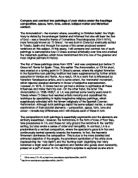The setting chosen by Ray for this scene is of great significance. The Griffith observatory, this in its vastness shows the characters are insignificant in the whole scheme of things. This enormity is also replicated later in the film by the darkness of the bluff where the chicky race takes places.
The dialogue spoken also reiterates this sense of insignificance. “The problems of man seem trivial and naïve indeed and man existing alone seems himself an episode of little consequence”. This also reverberates due to the fact Jim, Judy and Plato are all ’alone’ and must find each other to enable them to exist. “What does he know about man alone” spoken by Plato give you yet another insight into the loneliness and torment felt by the poor kid.
The reactions of all three major characters to the explosion and the “compared to characters around them. All three have a look of fear and worry, Plato is obviously terrified this is illustrated by the way he hides from it all, Judy is obviously frightened and Jim seems to be hiding, this is illustrated by the way his eyes are closed throughout and also by his posture he has his shoulders up around his ears as if he is protecting himself from something.
The isolation of both Jim and Plato’s is a major reoccurring theme in Rebel. The placement of the characters in the auditorium gives an insight into where they sit in current social standings. Plato is seated away from the rest of the group whereas Jim sits between both the group and Plato sort of in a state of transition. This is also seen in what costumes the characters are wearing. At the start of the film both Jim and Plato wear suits and ties, this enabled them to stand out from the crowd and be easily identified where most the other characters are wearing inconspicuous attire that easily allows them to blend in. However in the planetarium scene only Plato remains fully decked out in his suit and tie with Jim dressing down without a tie then allows Plato to stand out even more. This indicates an attempted transition from social outcast to becoming socially acceptable. Jims isolation is also obvious by the way he arrives to the planetarium late and alone this further shows that he is not part of any group.
During the scene Buzz makes a joke on one of the other ‘bad’ guys “Look Im a crab”, Jim then tries to join in by mooing like a cow however this attempt to integrate but is rejected by the popular group then as a defence mechanism when addressed by Plato he says “I don’t want to make friends” but it is obvious that this is not true by his body language afterwards but looks miserable in himself they way he has sunken into himself and the look of dejection on his face.
The relationship between Plato and Jim is a major one throughout the film. The planetarium scene is the first one though were you get a real sense of its severity. As Jim first enters the auditorium Plato’s face lights, this is also shown later in the scene when Jim makes a throw away comment about space and Plato replies with an excited “What“ this shows that Plato’s has been paying close attention to Jim and what he’s doing. This relationship or obsession is further revealed during the “end of the world” explosion when Plato hides behind Jim like a scared child behind his father. Jims paternal leaning are also built upon in this scene. We have already seen the start of this in the opening credits where he covers up the mechanical clapping monkey and then again in the Police Station when he offers Plato his jacket. In this sequence after the whole bang of the end of the world Jim reassures Plato that everything is alright “Its ok the world ended”. Jim is also standing over Plato again sort of a father and son relationship.
The connections between all the characters is also prominent in this scene. First you seen all the popular group sitting very close in a sort of tribal arrangement with their arms around in each other. However also the sneeze which could seem insignificant connects the three major characters together by making a direct link between Jim and Plato to Judy who is sitting in front of them.
Lighting is also used in this scene. The planetarium is dark as to define the infinites of space, however the main characters and well lit. The blue lightening flashes of the explosion give a sense of coldness and loneliness.
Nicholas Ray’s Rebel without a cause paved the way for the plethora of teen angst films that have flooded the market in the past three decades. The many elements of mis en scene that are utilised to relay the story of these youths is an amazing feat which along with the great story makes this film unforgettable.
Bibliography
Rebel Without a Cause. Dir. Nicholas Ray. Perf. James Dean, Natalie Wood & Sal Mineo, 1955. DVD. 2005.
Bordwell, David and Thompson, Kristin, Film Art: An Introduction (7th ed) New York: McGraw Hill, 2004.







